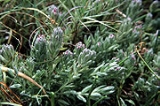
Cordylanthus
Encyclopedia
Cordylanthus is a genus of plants in the broomrape family
native to western North America. They are known commonly as bird's beaks. Like other broomrape relatives, bird's beaks are root parasites
which insert haustoria
into the roots of host plants to obtain nutrients. These are spare, weedy-looking annual plants with long branching erect stems and little foliage. Many bear bird's-beak-shaped
flowers in shades of pink or purple.
Selected species:
Orobanchaceae
Orobanchaceae, the broomrape family, is a family of flowering plants of the order Lamiales, with about 90 genera and more than 2000 species. Many of these genera were formerly included in the family Scrophulariaceae sensu lato...
native to western North America. They are known commonly as bird's beaks. Like other broomrape relatives, bird's beaks are root parasites
Parasitic plant
A parasitic plant is one that derives some or all of its sustenance from another plant. About 4,100 species in approximately 19 families of flowering plants are known. Parasitic plants have a modified root, the haustorium, that penetrates the host plant and connects to the xylem, phloem, or...
which insert haustoria
Haustorium
In botany, a haustorium is the appendage or portion of a parasitic fungus or of the root of a parasitic plant that penetrates the host's tissue and draws nutrients from it. Haustoria do not penetrate the host's cell membranes.Fungi in all major divisions form haustoria...
into the roots of host plants to obtain nutrients. These are spare, weedy-looking annual plants with long branching erect stems and little foliage. Many bear bird's-beak-shaped
Beak
The beak, bill or rostrum is an external anatomical structure of birds which is used for eating and for grooming, manipulating objects, killing prey, fighting, probing for food, courtship and feeding young...
flowers in shades of pink or purple.
Selected species:
- Cordylanthus capitatusCordylanthus capitatusYakima bird's-beak, also called clustered bird's-beak , is an uncommon plant of the Western U.S.- Technical Description :...
- Yakima bird's beak - Cordylanthus eremicusCordylanthus eremicusCordylanthus eremicus is a species of flowering plant in the broomrape family known by the common name desert bird's beak.It is endemic to California, where it is known from dry mountainous habitat in the San Bernardino Mountains, the mountains of the Mojave Desert region, and the Kern Plateau in...
- desert bird's beak - Cordylanthus maritimusCordylanthus maritimusCordylanthus maritimus is a rare species of flowering plant in the broomrape family known by the common names salt marsh bird's beak and Point Reyes bird's beak.-Distribution:...
- saltmarsh bird's beak - Cordylanthus mollisCordylanthus mollisCordylanthus mollis is a species of flowering plant in the broomrape family known by the common name soft bird's beak.It is endemic to California, where it is known in coastal and inland salt marshes in the Central Valley, particularly the Sacramento-San Joaquin River Delta.-Subspecies:Both...
- soft bird's beak - Cordylanthus neviniiCordylanthus neviniiCordylanthus nevinii is a species of flowering plant in the broomrape family known by the common name Nevin's bird's beak. It is native to pine and oak forests and woodlands in southern California, western Arizona, and northern Baja California....
- Nevin's bird's beak - Cordylanthus nidulariusCordylanthus nidulariusCordylanthus nidularius is a rare species of flowering plant in the broomrape family known by the common name Mt. Diablo bird's beak. It is endemic to Mount Diablo in the San Francisco Bay Area in California, where it grows in chaparral on serpentine soils. This small annual herb is red-tinted...
- Mt. Diablo bird's beak - Cordylanthus orcuttianusCordylanthus orcuttianusCordylanthus orcuttianus is a rare species of flowering plant in the broomrape family known by the common name Orcutt's bird's beak. It is native to Baja California and southern San Diego County, California, where few populations are known. It is a plant of coastal scrub habitat...
- Orcutt's bird's beak - Cordylanthus palmatusCordylanthus palmatusCordylanthus palmatus is a rare species of flowering plant in the broomrape family known by the common names palmate bird's beak and palmbract bird's beak. It is endemic to the Central Valley of California, where it is known from a few remaining occurrences in the rare alkali sink habitat type...
- palmbract bird's beak - Cordylanthus parviflorusCordylanthus parviflorusCordylanthus parviflorus is a species of flowering plant in the broomrape family known by the common name purple bird's beak. It is native to the western United States where it grows in several types of habitat, including the sagebrush steppe of the Great Basin. It is an annual herb, red-tinted...
- purple bird's beak - Cordylanthus pilosusCordylanthus pilosusCordylanthus pilosus is a species of flowering plant in the broomrape family known by the common name hairy bird's beak. It is endemic to the mountain ranges and foothills of northern California, where it grows in woodland and chaparral habitat, often on serpentine soils. There are three...
- hairy bird's beak - Cordylanthus ramosusCordylanthus ramosusCordylanthus ramosus is a species of flowering plant in the broomrape family known by the common name bushy bird's beak. It is native to the western United States where it grows in mountains and plateau, including the sagebrush of the Great Basin...
- bushy bird's beak - Cordylanthus rigidusCordylanthus rigidusCordylanthus rigidus is a species of flowering plant in the broomrape family known by the common name stiffbranch bird's beak.It is native to California and northern Baja California, where it grows in many types of habitat from coastal flats to high inland mountains. This is a hairy annual herb...
- stiffbranch bird's beak - Cordylanthus tecopensis - Tecopa bird's beak
- Cordylanthus tenuisCordylanthus tenuisCordylanthus tenuis is a species of flowering plant in the broomrape family known by the common name slender bird's beak. It is native to the US states of California, Oregon, and Nevada, where it grows in woodland and forest...
- slender bird's beak

